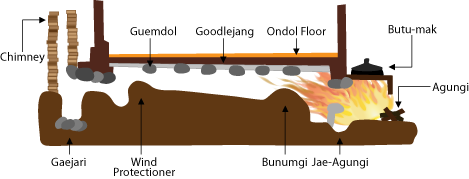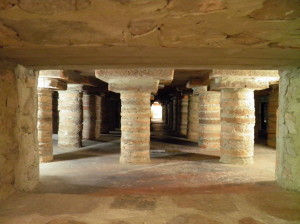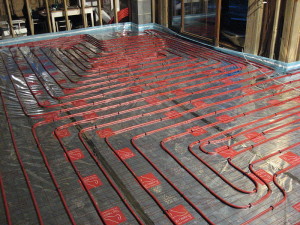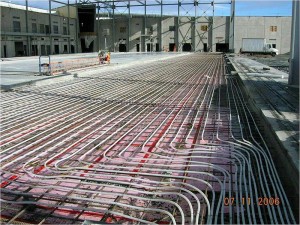Radiant Heat Flooring
History
While radiant heat flooring might seem like a purely modern achievement, the roots of this technology extend back for millenia. The first known evidence for primitive underfloor heating comes from the Xinle culture in northeast China, dating to 5200 BCE. Excavated sites from around 1000 BCE in nearby Korea show a much more sophisticated system, called an ondol, where warm air and smoke directly heated stone and ceramic flooring from underneath.
While these ancient peoples of East Asia provide the earliest known underfloor heating systems, they were generally only used on a small, private scale. Roman innovations took this technology to entirely new heights. Hypocausts (from hypo meaning “under” and caust meanting “burnt”) were used to heat not only private houses, but entire public buildings and baths as well. Floors were held up by evenly spaced pillars. The space between the ground and the floor was used to maintain wood-burning furnaces, which were usually tended and fanned by servants and slaves. Walls were left hollow so that hot air and smoke could travel up through them and out the roof of the buildings, heating the interior without polluting the rooms. With the fall of the Rome, a heating system of such sophistication would not be seen in the Western world for close to fifteen hundred years.
Principles and Advantages
Besides the oh-so-lovely feeling of warmth emanating from directly under your feet, there are real advantages to using an underfloor radiant heat system. In conventional forced air heating systems, warm air only enters a building at a few points. What’s more, as we are all taught in elementary school fire drills, this warm air tends to rise to the ceiling where it cools before falling back down, leaving the area closest to the ground as the coolest part of a room. This can make keeping your toes warm especially difficult!
With an underfloor heating system, the warmest air is concentrated near the ground, meaning you can stay warm and not waste money heating your ceiling. The benefits of an underfloor system don’t stop there, however. Radiant heat also keeps the air inside a building cleaner, eliminating the airborne debris, bacteria, mold, and dust mites associated with forced air. The hidden nature of underfloor systems also means that there is no risk of burns associated with a traditional furnace. Add to this the fact that many underfloor systems are more energy efficient that their traditional counterparts and you have a lot to like.
Modern Types
Today’s underfloor radiant heat systems fall into two main types, electric-based and fluid-based (or “hydronic”). Each type can be used as the primary heating system and can be placed above or below the subfloor, but they do have different strengths and weaknesses, as detailed below:
Electric
- Can only be used for heating
- Easier and more affordable to install
- Operational costs are more expensive
- Retrofitting buildings with electric system is usually straightforward
- Ideal for on-demand heating; also ideal for heating small strategic spaces such as bathrooms
Hydronic
- Can be used for heating and cooling
- More expensive and complicated to install, often requiring experienced designers and installers
- Operational costs are less expensive
- Retrofitting is often impractical
- Ideal for sustained heat – minimal energy required to maintain warmth
Flooring Materials
When it comes to underfloor radiant heat systems, not all flooring materials are created equal. The best materials to use with such a setup are good at conducting heat and include stone, concrete, and ceramic tile. Vinyl and plastic laminate are okay and heat quickly, but do not conduct or store heat as well. Wood floors often expand and shrink with the changing temperatures brought on by underfloor systems, which can result in cracking and visible gaps between boards. However, an installer experienced with underfloor heating systems can make wood floors work well. Lastly, it should be noted that carpet is generally inappropriate to use in conjunction with any type of underfloor radiant heat source, as it will act as an insulator and keep the heat trapped below the floor.
What To Do Next
If you are interested in learning how to install your own underfloor heating system, stay tuned. We will detail the basics of the process right here at the Wholesale Log Homes blog next month. Otherwise, it might be a good idea to take any questions you have to your builder or an experienced underfloor heat system installer. Need help finding one? Contact us and we might be able to help you.





